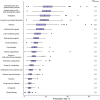Prescription Rates, Polypharmacy and Prescriber Variability in Swiss General Practice-A Cross-Sectional Database Study
- PMID: 35237170
- PMCID: PMC8884695
- DOI: 10.3389/fphar.2022.832994
Prescription Rates, Polypharmacy and Prescriber Variability in Swiss General Practice-A Cross-Sectional Database Study
Abstract
Purpose: The frequency of medication prescribing and polypharmacy has increased in recent years in different settings, including Swiss general practice. We aimed to describe patient age- and sex-specific rates of polypharmacy and of prescriptions of the most frequent medication classes, and to explore practitioner variability in prescribing. Methods: Retrospective cross-sectional study based on anonymized electronic medical records data of 111 811 adult patients presenting to 116 Swiss general practitioners in 2019. We used mixed-effects regression analyses to assess the association of patient age and sex with polypharmacy (≥5 medications) and with the prescription of specific medication classes (second level of the Anatomical Therapeutic Chemical Classification System). Practitioner variability was quantified in terms of the random effects distributions. Results: The prevalence of polypharmacy increased with age from 6.4% among patients aged 18-40 years to 19.7% (41-64 years), 45.3% (65-80 years), and 64.6% (81-92 years), and was higher in women than in men, particularly at younger ages. The most frequently prescribed medication classes were antiinflammatory and antirheumatic products (21.6% of patients), agents acting on the renin-angiotensin system (19.9%), analgesics (18.7%), and drugs for acid related disorders (18.3%). Men were more often prescribed agents targeting the cardiovascular system, whereas most other medications were more often prescribed to women. The highest practitioner variabilities were observed for vitamins, for antiinflammatory and antirheumatic products, and for mineral supplements. Conclusion: Based on practitioner variability, prevalence, and risk potential, antiinflammatory drugs and polypharmacy in older patients appear to be the most pressing issues in current drug prescribing routines.
Keywords: Switzerland; clinical practice variation; demographic aging; drug prescriptions; polypharmacy; primary care; sex differences.
Copyright © 2022 Rachamin, Jäger, Meier, Grischott, Senn, Burgstaller and Markun.
Conflict of interest statement
The authors declare that the research was conducted in the absence of any commercial or financial relationships that could be construed as a potential conflict of interest.
Figures




Similar articles
-
Drug Prescription in Older Swiss Men and Women Followed in Family Medicine.Drugs Real World Outcomes. 2020 Mar;7(1):87-95. doi: 10.1007/s40801-019-00175-6. Drugs Real World Outcomes. 2020. PMID: 31845213 Free PMC article.
-
Psychotropic medication use among elderly nursing home residents in Slovenia: cross-sectional study.Croat Med J. 2011 Feb;52(1):16-24. doi: 10.3325/cmj.2011.52.16. Croat Med J. 2011. PMID: 21328716 Free PMC article.
-
Drug Prescription Profiles in Patients with Polypharmacy in Spain: A Large-Scale Pharmacoepidemiologic Study Using Real-World Data.Int J Environ Res Public Health. 2021 Apr 29;18(9):4754. doi: 10.3390/ijerph18094754. Int J Environ Res Public Health. 2021. PMID: 33946914 Free PMC article.
-
Medication use in older patients and age-blind approach: narrative literature review (insufficient evidence on the efficacy and safety of drugs in older age, frequent use of PIMs and polypharmacy, and underuse of highly beneficial nonpharmacological strategies).Eur J Clin Pharmacol. 2019 Apr;75(4):451-466. doi: 10.1007/s00228-018-2603-5. Epub 2019 Jan 4. Eur J Clin Pharmacol. 2019. PMID: 30610276 Review.
-
Expert-based medication reviews to reduce polypharmacy in older patients in primary care: a northern-Italian cluster-randomised controlled trial.BMC Geriatr. 2021 Nov 23;21(1):659. doi: 10.1186/s12877-021-02612-0. BMC Geriatr. 2021. PMID: 34814835 Free PMC article. Review.
Cited by
-
Epidemiology and association with outcomes of polypharmacy in patients undergoing surgery: retrospective, population-based cohort study.BJS Open. 2023 May 5;7(3):zrad041. doi: 10.1093/bjsopen/zrad041. BJS Open. 2023. PMID: 37194458 Free PMC article.
-
The impact of the COVID-19 pandemic on rates of adolescents receiving psychopharmacological medication in Austria.Child Adolesc Psychiatry Ment Health. 2024 Jan 13;18(1):10. doi: 10.1186/s13034-023-00684-x. Child Adolesc Psychiatry Ment Health. 2024. PMID: 38218981 Free PMC article.
-
Quality and variation of care for chronic kidney disease in Swiss general practice: A retrospective database study.PLoS One. 2022 Aug 11;17(8):e0272662. doi: 10.1371/journal.pone.0272662. eCollection 2022. PLoS One. 2022. PMID: 35951667 Free PMC article.
-
Ambient temperature and kidney function in primary care patients.J Nephrol. 2024 Jan;37(1):95-105. doi: 10.1007/s40620-023-01715-8. Epub 2023 Aug 23. J Nephrol. 2024. PMID: 37610683 Free PMC article.
References
LinkOut - more resources
Full Text Sources

